牛津英语7aunit5重点难点讲解教案
沪教牛津版英语五年级上册教案-Unit 5 Friends
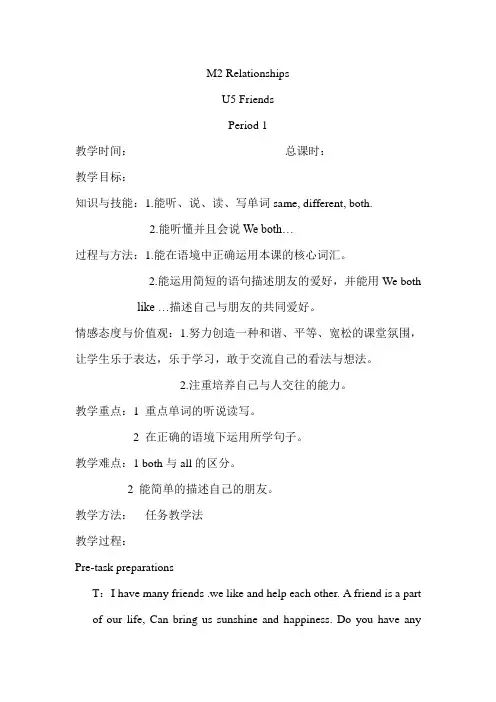
M2 RelationshipsU5 FriendsPeriod 1教学时间:总课时:教学目标:知识与技能:1.能听、说、读、写单词same, different, both.2.能听懂并且会说We both…过程与方法:1.能在语境中正确运用本课的核心词汇。
2.能运用简短的语句描述朋友的爱好,并能用We bothlike …描述自己与朋友的共同爱好。
情感态度与价值观:1.努力创造一种和谐、平等、宽松的课堂氛围,让学生乐于表达,乐于学习,敢于交流自己的看法与想法。
2.注重培养自己与人交往的能力。
教学重点:1 重点单词的听说读写。
2 在正确的语境下运用所学句子。
教学难点:1 both与all的区分。
2 能简单的描述自己的朋友。
教学方法:任务教学法教学过程:Pre-task preparationsT:I have many friends .we like and help each other. A friend is a part of our life, Can bring us sunshine and happiness. Do you have anyfriends? 教师大屏幕出示Alice 和小狗玩耍的图片。
逐步出示问题。
T: Do you have any friends?Ss: Yes, I do.T: Who is your best friends?Ss: XXX is.T: What does he/she look like?Ss: He/She is tall/thin.He/She has big eyes…T: Are you in the same school? (师着重读same,引出新授单词same.)Ss: Yes , we are.While-task procedures1.大屏幕出示图片教授单词same, 根据发音规则拼读单词。
然后出示两只不同蝴蝶的画面,新授单词different, 师领读,生跟读。
新牛津译林版五年级英语下册Unit5 第3课时教案
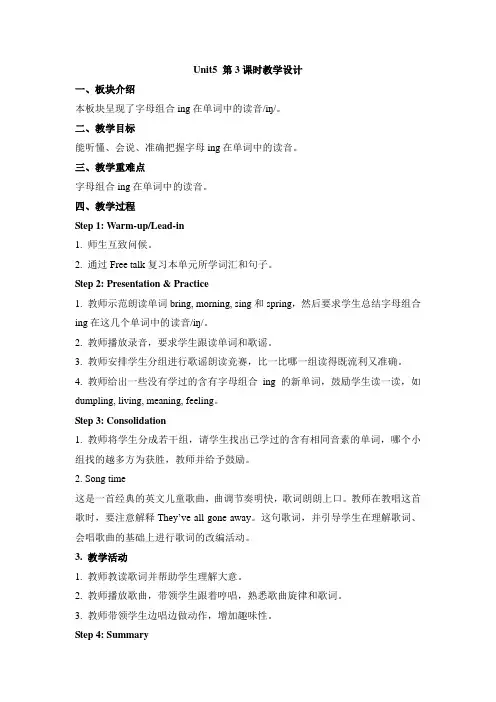
一、概述重组家庭是指由离婚或丧偶的父母重新组建家庭,其中可能包括自己的子女以及配偶双方的子女。
这种家庭形式在现代社会中逐渐增多,但由于家庭成员之间的血缘关系并非直系亲属,可能存在一些与传统家庭不同的问题和挑战。
对于重组家庭而言,家庭教育的重要性尤为突出,因此有必要针对重组家庭的家庭教育指导策略进行深入探讨。
二、了解家庭成员的感受1. 重组家庭的孩子可能面临情感困扰,他们需要理解并接受新的家庭成员,同时也需要处理和父母、兄弟姐妹之间的关系。
家长应当倾听孩子的心声,了解他们的内心感受,给予足够的关爱和安全感。
2. 失去亲生父母或真正家庭的孩子可能存在认同问题,因此建立身份认同感是非常必要的。
家长可以通过各种方式,例如定期与孩子交流聊聊,参与孩子所在学校或社交圈的活动,帮助孩子树立自信和认同感。
三、建立和谐的家庭氛围1. 家庭成员之间的相互尊重和包容是建立和谐家庭氛围的关键。
家长应当示范出良好的行为模范,引导孩子学会尊重和体谅他人。
2. 家庭成员之间的交流问题也是影响整个家庭氛围的重要因素。
家长可以鼓励家庭成员之间开展有效交流,包括在日常生活中倾听对方的想法、意见和感受,解决家庭内部的矛盾和问题。
四、帮助家庭成员适应新环境1. 重组家庭的孩子可能需要时间来适应新的家庭环境和生活方式。
家长需要给予足够的耐心和理解,同时也需要提供一定的支持和帮助。
2. 家长也可以通过帮助孩子建立新的社交圈和友谊关系,以及鼓励他们参与各种社交活动来帮助他们更好地融入新的生活环境。
五、制定家庭规则和价值观1. 制定家庭规则对于重组家庭尤为重要,这有助于建立和谐的家庭秩序和氛围。
家长需要与家庭成员共同制定家庭规则,并教育他们遵守这些规则。
2. 家庭价值观也是影响家庭教育的重要因素之一。
建立积极向上的家庭价值观,如尊重他人、诚实守信、团结互助等,有助于引导家庭成员树立正确的人生观和价值观。
六、寻求专业帮助1. 针对重组家庭的家庭教育指导策略可能需要借助专业机构和专家的帮助。
Unit5教案2023-2024学年牛津译林版七年级英语下册
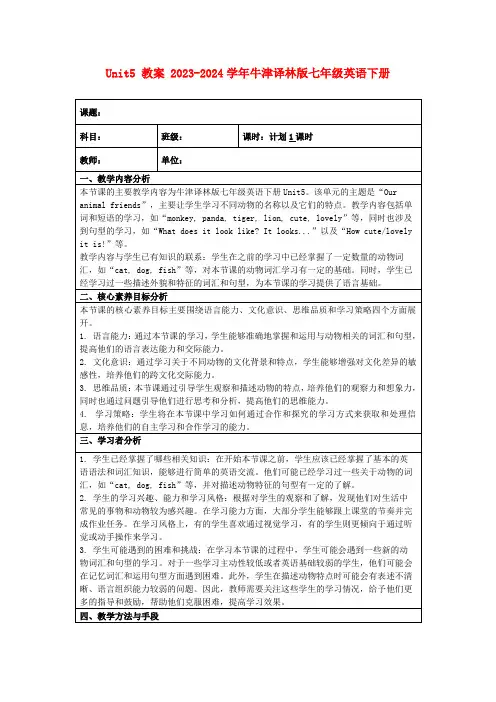
4. 学生小组讨论(10分钟)
目标: 培养学生的合作能力和解决问题的能力。
过程:
将学生分成若干小组,每组选择一个与动物相关的主题进行深入讨论。
小组内讨论该主题的现状、挑战以及可能的解决方案。
每组选出一名代表,准备向全班展示讨论成果。
教学手段:
1. 多媒体教学:利用多媒体设备,如投影仪、电脑等,展示动物图片、视频和音频材料,丰富教学内容,提高学生的学习兴趣和参与度。
2. 教学软件:运用教学软件,如互动式英语学习平台等,提供个性化的学习资源和方法,帮助学生自主学习和巩固知识。
3. 实物教具:使用动物模型、图片等实物教具,帮助学生直观地学习和记忆动物词汇和句型,提高学习效果。
四、教学方法与手段
教学方法:
1. 情境教学法:通过展示动物图片、视频等,引导学生进入学习情境,激发他们的学习兴趣和主动性。
2. 任务型教学法:通过设计各种任务,如小组讨论、角色扮演等,让学生在实践中学习和运用英语,提高他们的语言能力和合作能力。
3. 差异教学法:根据学生的不同学习水平和兴趣,提供不同难度的学习材料和任务,让每个学生都能在自己的水平上得到提高和发展。
过程:
简要回顾本节课的学习内容,包括动物的基本概念、组成部分、案例分析等。
强调动物在现实生活或学习中的价值和作用,鼓励学生进一步探索和应用动物知识。
布置课后作业:让学生撰写一篇关于动物的短文或报告,以巩固学习效果。
六、教学资源拓展
1. 拓展资源:
- 动物科普书籍:提供一些关于动物的科普书籍,如《动物世界》、《恐龙百科》等,让学生深入了解各种动物的特性、生活习性和生态环境。
牛津译林版六年级上册英语Unit5 on the farm教案
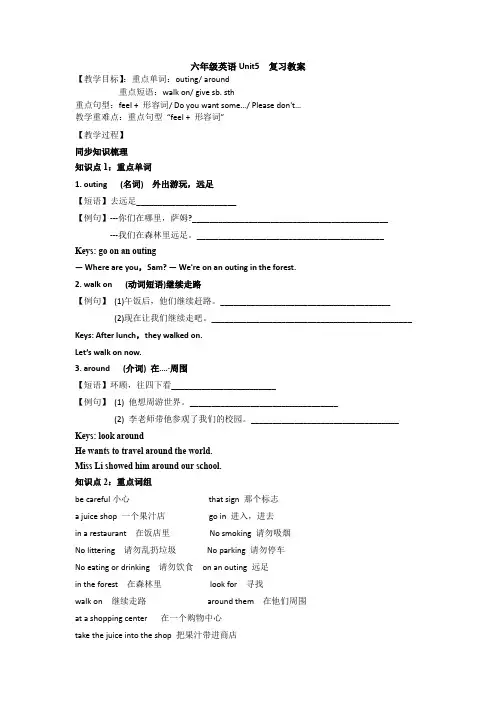
六年级英语Unit5 复习教案【教学目标】:重点单词:outing/ around重点短语:walk on/ give sb. sth重点句型:feel + 形容词/ Do you want some…/ Please don't…教学重难点:重点句型“feel + 形容词”【教学过程】同步知识梳理知识点1:重点单词1. outing (名词) 外出游玩,远足【短语】去远足_______________________【例句】---你们在哪里,萨姆?_____________________________________________ ---我们在森林里远足。
___________________________________________ Keys: go on an outing— Where are you,Sam? — We're on an outing in the forest.2. walk on (动词短语)继续走路【例句】(1)午饭后,他们继续赶路。
_______________________________________(2)现在让我们继续走吧。
______________________________________________ Keys: After lunch,they walked on.Let’s walk on now.3. around (介词) 在.…·周围【短语】环顾,往四下看________________________【例句】(1) 他想周游世界。
__________________________________(2) 李老师带他参观了我们的校园。
__________________________________ Keys: look aroundHe wants to travel around the world.Miss Li showed him around our school.知识点2:重点词组be careful小心that sign 那个标志a juice shop 一个果汁店go in 进入,进去in a restaurant 在饭店里No smoking 请勿吸烟No littering 请勿乱扔垃圾No parking 请勿停车No eating or drinking 请勿饮食on an outing 远足in the forest 在森林里look for 寻找walk on 继续走路around them 在他们周围at a shopping center 在一个购物中心take the juice into the shop 把果汁带进商店知识点2:重点句型1. Bobby and Sam are on an outing①in the forest② . It is time for lunch. Bobby feels tired③ and hungry.波比和萨姆在森林里远足。
译林牛津版五年级英语下册教案 Unit5 第1课时
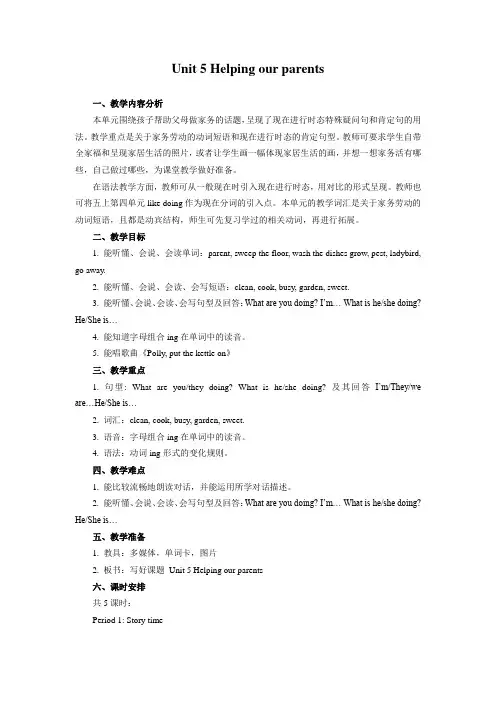
Unit 5 Helping our parents一、教学内容分析本单元围绕孩子帮助父母做家务的话题,呈现了现在进行时态特殊疑问句和肯定句的用法。
教学重点是关于家务劳动的动词短语和现在进行时态的肯定句型。
教师可要求学生自带全家福和呈现家居生活的照片,或者让学生画一幅体现家居生活的画,并想一想家务活有哪些,自己做过哪些,为课堂教学做好准备。
在语法教学方面,教师可从一般现在时引入现在进行时态,用对比的形式呈现。
教师也可将五上第四单元like doing作为现在分词的引入点。
本单元的教学词汇是关于家务劳动的动词短语,且都是动宾结构,师生可先复习学过的相关动词,再进行拓展。
二、教学目标1. 能听懂、会说、会读单词:parent, sweep the floor, wash the dishes grow, pest, ladybird, go away.2. 能听懂、会说、会读、会写短语:clean, cook, busy, garden, sweet.3. 能听懂、会说、会读、会写句型及回答:What are you doing? I’m… What is he/she doing? He/She is…4. 能知道字母组合ing在单词中的读音。
5. 能唱歌曲《Polly, put the kettle on》三、教学重点1. 句型: What are you/they doing? What is he/she doing? 及其回答I’m/They/we are…He/She is…2. 词汇:clean, cook, busy, garden, sweet.3. 语音:字母组合ing在单词中的读音。
4. 语法:动词ing形式的变化规则。
四、教学难点1. 能比较流畅地朗读对话,并能运用所学对话描述。
2. 能听懂、会说、会读、会写句型及回答:What are you doing? I’m… What is he/she doing? He/She is…五、教学准备1. 教具:多媒体,单词卡,图片2. 板书:写好课题Unit 5 Helping our parents六、课时安排共5课时:Period 1: Story timePeriod 2: Grammar timePeriod 3: Fun & Sound & Song timePeriod 4: Cartoon timePeriod 5: Revision & Checkout time& Exercises第1课时(总第课时)上课时间:月日课型:课一、教学内容Unit 5 Helping our parents (Story time)二、教学目标1. 能听懂、会说、会读、会写词汇:help, parents, clean, kitchen, living room, bedroom, busy.2. 能听懂、会说、会读、会写短语:clean the car, sweep the floor, cook breakfast, cook dinner, wash dishes, clean the table, make the bed.3. 理解、会读、会说句型:What is…doing?…is + V-ing.三、教学重点1. 能听懂、会说、会读、会写词汇:help, parents, clean, kitchen, living room, bedroom, busy.2. 能听懂、会说、会读、会写短语:clean the car, sweep the floor, cook breakfast, cook dinner, wash dishes, clean the table, make the bed.四、教学难点1. 能正确理解并朗读课文,在教师的帮助下尝试复述课文。
上海沪教牛津版(三起)四年级下册英语教案-Unit 5 Sport
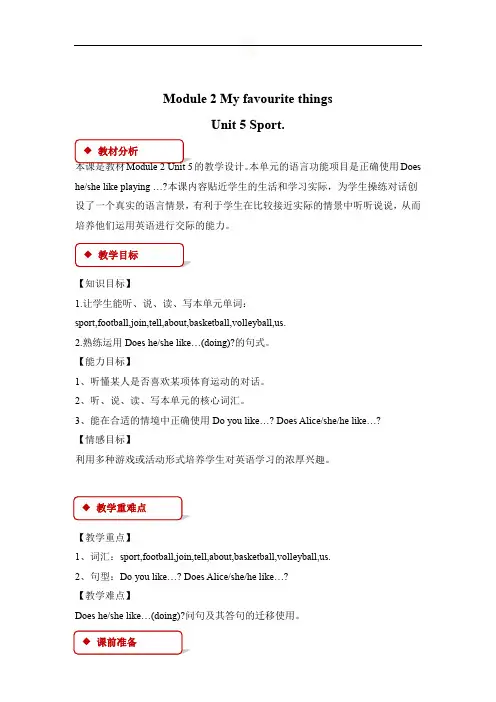
Module 2 My favourite thingsUnit 5 Sport.◆教材分析本课是教材Module 2 Unit 5的教学设计。
本单元的语言功能项目是正确使用Does he/she like playing…?本课内容贴近学生的生活和学习实际,为学生操练对话创设了一个真实的语言情景,有利于学生在比较接近实际的情景中听听说说,从而培养他们运用英语进行交际的能力。
◆教学目标【知识目标】1.让学生能听、说、读、写本单元单词:sport,football,join,tell,about,basketball,volleyball,us.2.熟练运用Does he/she like…(doing)?的句式。
【能力目标】1、听懂某人是否喜欢某项体育运动的对话。
2、听、说、读、写本单元的核心词汇。
3、能在合适的情境中正确使用Do you like…? Does Alice/she/he like…?【情感目标】利用多种游戏或活动形式培养学生对英语学习的浓厚兴趣。
◆教学重难点◆【教学重点】1、词汇:sport,football,join,tell,about,basketball,volleyball,us.2、句型:Do you like…? Does Alice/she/he like…?【教学难点】Does he/she like…(doing)?问句及其答句的迁移使用。
◆课前准备◆Useful phrases and sentences.◆教学过程活动1【导入】(一)Pre-task preparation1、播放多媒体课件,学生观看后进行小组讨论。
2、出示单词卡片,教学生词。
3、列出人名和不同的项目名称,将人物与对应的体育运动项目配对。
活动2【讲授】(二)While-task procedure1、播放Listen and say的录音,学生模仿录音朗读课文。
2、学生两人一组,根据自己喜欢的运动改编对话并表演。
五年级英语下册 Unit 5(3)教案 苏教牛津版
How are you?
What’s wrong with you?
Are you taking any medicine?
How do you feel now?
B.自学展示
1.学生根据情景表演对话。
2.学生回答复习所学词汇和句型:
教师出示B部分挂图
T: Good morning. /afternoon.
T: What’s wrong with you?
师出示图片。
师评价。
1必做:根据复习内容,自己创设情景进行交谈。
2必做:抄写第二单元四会单词和句型四遍。
3 选做:本节课上回答问题有困难的学生听读第二单元五遍。
4 选做:复习第三单元并准备谈论自己爱好(不少于四句话)
S: I feel ill.
S:I’ve got a fБайду номын сангаасver.
( a toothache, an earache, a backache,a headache,a stomach ache, a cold, a cough)
3.幸运52游戏:一位学生表演,其余学生猜:toothache, earache, backache,headache,stomach ache,cold,cough。
(苏教牛津版)五年级英语下册教案
Unit 5 Review and check
课题
5BUnit5 B部分 (第二课时)
教学目标
1.通过复习,学生进一步掌握第二单元的四会单词和句型。
2.通过复习,学生能灵活使用第二单元日常交际用语。
3.完成本单元B部分内容,掌握介词的用法。
苏教版牛津英语unit5教案及练习(含答案)
9A Unit 5 Films Integrated Skills 教案第7课时知识目标:1. To identify the context of a cinema hotline2. To identify key points to complete some notes about three different films能力目标:To talk about different types of films and preferences in films情感目标:To express one's own idea about films教学重点:To identify key points to complete some notes about three different films教学难点:To talk about different types of films and preferences in films预习作业:翻译下列词组:1. 电影节2. 写关于电影的报告3. 电影指南4. 被选中成为.......5. 适合于......6. 于某人相爱......7. 对人们有不良的影响8. 恐怖的一些事情9. 恐龙世界10. 老北京的故事教学进程:检查预习作业。
Step 1 RevisionRevise: (show the power point) 15'1. What types of films are they?①. Audrey Hepburn : Romantic filmIt’s about a young prince who met a young reporter in Roman and they fell in love with each other (fall in love with/be in love with)②.Tiger Watch: DocumentaryIt is about Asian tigers in danger.③. A murder in a country house: Horror filmIt’s about a doctor who was found in a country house.④. The end of the world: Science fiction filmWhat happened to the world because of virus?(学生活动:Watch the pictures and guess the type)Step 2. Presentation:20'1. There is a film festival in Sunshine Town, there are three films, Sandy want s to watch all of them, but She can only watch one film because she has not enough money. Here is the cinema guide. Please guess the types of the films The T ales of Old Beijing The World of Dinosaurs Love Ship2. Listen to the tape and find out the answers.(学生活动:Think and discuss.)3. Read the cinema guide and fill in the information onP92 Part A14. Sandy has read the cinema guide,so she want s to write the information about the three 's listen to the tape and finish the Part A2 on P93(学生活动:Fill in the information)5. Language points区别alive/ livingalive : adj,可以用作表语与定语T he greatest man alive keep alive/ stay aliveliving :adj Living animals He is still living.注意词性Show: vi/vtThe cinema is showing Tales of Old BeijingTales of Old Beijing is showing in the cinema.Tales of Old Beijing is show n/on in the cinema.Step 3. Exercise 10'见9A Unit 5 Films 学案Step 4. Homework1. complete some exercises on <Fedback>2. Preview speak up and study skills9A Unit 5 Films Integrated Skills学案学习目标:辞汇:书后单词表中的单词和课文中出现的词组重要句型:what do you think about fights in action films?(这是Speak up 上的一个句子,本课时并无把Speak up作为教学内容)预习案:1. 温习本单元学过的知识点和单词2. 预习Integrated skills 的新单词和讲义内容。
七年级英语下册 Unit 5教案 牛津上海版
Unit 5 What can we learn from others教学目标Teaching objectives:Language learning objectives:By the end of the lesson the students will be able to pronounce, know the meanings of the key words in the context of “The happy farmer and his wife”By the end of the lesson the students will be able to get the main meaning and read fluently.Ability objectives:1. By the end of the lesson the students will have practiced guessing the meanings of the words in the context.2. By the end of the lesson the students will have practiced reading skills of skimming, predicting and scanning.三.Character training objectives:1. By the end of the lesson the students will have learned that a man who is contented will always have happiness. (Never to be greedy.)2学情分析学情分析:本次执教的七年级(二)班,英语基础比较薄弱。
班级中有少许同学思维活跃,但是由于英语水平和表达能力的限制,出现“愿说却说不好”的现象。
Unit5提优版教案牛津译林版七年级英语下册
江苏译林七年级下册Unit5 Wele to Sunshine Town一、教学目标1.巩固本单元新单词2.掌握本单元的重难点句型并熟练运用二、课堂引入I.课前小测1.Thank you very much for (give) me a hand.2.I (get)to the theatre at 7:30 yesterday evening.3.The man came into the room (quiet)and did some reading.4.Were Millie and Amy (surprise) to find the monster just now?5.Suzy is not afraid of (speak) in front of many people.6.Someone (make)a sound like a whisper in the dark room just now.7.My parents said they planned (visit) my grandma next weekend.8.Mary got hurt in PE class. We sent her to hospital (quick).9.No pain, no gain. Without (work) hard, no one can achieve success in life. 10.“Remember (bring) your notebook here next time,” the teacher said to the little boy. II.精讲精练一、知识点ic strip & Wele to the unit1.Look at that.看那。
(P56)look①连系动词“看起来” 后+形容词→You look tired/young/old.①实义动词(不及物)look at sth look there/here固定搭配:look after(well)=take (good) care of(2022·江苏南通·七年级校考期中)1.You should ________ yourselves, classmates.A.look for B.look up C.look around D.look after2.It’s a UFO.那是个UFO。
- 1、下载文档前请自行甄别文档内容的完整性,平台不提供额外的编辑、内容补充、找答案等附加服务。
- 2、"仅部分预览"的文档,不可在线预览部分如存在完整性等问题,可反馈申请退款(可完整预览的文档不适用该条件!)。
- 3、如文档侵犯您的权益,请联系客服反馈,我们会尽快为您处理(人工客服工作时间:9:00-18:30)。
1. I want you to go shopping with me today.今天我想要你和我一起去购物。(P70) 此句型为want sb. to do sth.,意为“想要某人干某事”,want是及物动词,to do sth.为动词不定式作宾语补足语。例如: He wants me to help her with her maths.他想要我在数学方面帮助她。 want还可接名词或动词不定式作宾语,即want sth.或want to do sth.。例如: She wants a pair of jeans.她想要一条牛仔裤。 I want to buy a lot of things.我想要买许多东西。(P70) I want to see my parents this weekend.这个周末我想去看望我的父母亲。 ’m not free today.我今天没空。(P70) free是形容词,意为“空闲的,有空的”。常与be (am, is are, was, were)动词连用。例如: She is not free now.她现在没空。 Are you free this evening? 你今晚有空吗? need you to carry all the bags.我需要你拿所有的包。(P70) (1)此句型为need sb. to do sth.,意为“需要某人干某事”,need是及物动词,意为“需要”,to do sth.为动词不定式作宾语补足语。例如: He needs his parents to clean his bedroom.他需要父母亲打扫卧室。 need还可接名词或动词不定式作宾语,即need sth.或need to do sth.。例如: I need a lot of energy. 我需要许多能量。(P54) Do we need to buy some vegetables? 我们需要买些蔬菜吗 ?(P62) (2)carry意为“搬运、随身携带”,还含有“肩挑、手提”的意思。例如: Could you help me carry the box? 请你帮我拿这个箱子,好吗? bring和take也有“拿、带”的意思,但用法各不相同。 bring意为“拿来、带来”,指把某物或某人从别处带到说话处。例如: You must finish reading the magazine this evening and bring it here tomorrow.你必须今天晚上看完这本杂志,明天把它带到这儿来。 Your cousin asked me to bring you a birthday present. 你表哥让我给你带来一件生日礼物。 take意为“拿去、带去”,指把某物或某人从说话处带到别处去,它与bring所表示的方向相反。例如: Take away this empty bottle, and bring me a full one,please.把这个空瓶拿走,请给我拿个满的来。 I help you? 你想要点什么?(72) What can I do for you?我能帮你忙吗?(72) Can I help you? 与What can I do for you?两者可用来询问别人是否需要服务或提供帮助,意为“要我帮忙吗?”,在不同的场合表达不同的意义。例如:在图书馆,图书馆管理员对你说Can I help you?或What can I do for you?,表示:“您要借书吗?”在商店,营业员对顾客说,表示“您想要买点什么”。 Can I help you? 还可表达成:Could I help you? 或May I help you?,这两者在语气上要比Can I help you?更加客气、委婉。 ’m looking for some football cards and stickers of Huanghe Football Team. 我在找些足球卡片和黄河足球队的贴花纸。(P72) look for意为“找,寻找”。例如: He is looking for his comic book.他在找他的连环画。 She is looking for her mother.她在找她母亲。(P85) 6. There are some cards and stickers over here.那儿有些卡片和贴纸。(P72) over here意为“在这儿,在这边”,在句中可作状语。over here也可在句中作表语、定语。例如: My car is over here.我的车在这儿呢。(表语) You can ask the man over here.你可以问问这边的那个人。(定语) Please put your school things over here.请把你的学习用品放在这儿。(状语) 7. Take a look.看一看(P72) take a look 相当于have a look,意为“看一看”。若表示“看一看某物”时,则后跟介词at,表达为:take a look at…或have a look at…。例如: Take a look at her hair clips. How lovely! 看一看她的发夹,多漂亮啊! Let me have a look at your new watch, please. 请让我看一看你的新手表。 8. How much do the cards cost? 卡片多少钱?(72) (1)how much可用来询问价格、价钱,或对不可数名词的数量提问。例如: How much is your CD? It’s ten yuan.你的CD多少钱?10元。 How much does the Walkman cost? It’s about 120 dollars.这个随身听多少钱?大约120元。 (2)cost是动词,意为“花费”,其主语为物,后接表示“金钱”的名词作宾语。例如: This teddy bear costs twenty yuan.这只玩具熊20元。 表示“某人花钱干某事”,用spend的句型,其主语必须是人,动词用-ing形式。 He spent two hundred yuan buying this watch.他买这块手表花了200元。 spend后接名词时,用介词on。“他买这块手表花了200元。”这句也可表达成: He spent two hundred yuan on this watch. spend还可表示“某人花时间干某事”,这时用句型(人)spend some time on sth / doing sth.。例如: She usually spends half an hour on English. You mustn’t spend too much time playing volleyball. 也可用句型It takes sb. some time to do sth. 表示“干某事花某人多少时间”。例如: It usually takes her half an hour to read English.读英语花费她半小时。 It usually takes me more than two hours to do homework.家庭作业通常花我两个多小时。 9. I want to buy a present for my friend. (P72) buy意为“买”,表示“给某人买某物”时,可用句型buy sb sth,也可用give sth for sb。因此原句也可表达为:I want to buy my friend a present.。例如: I also want to buy a CD for her.= I also want to buy her a CD .我也想给她买个CD。(P72) I don’t have enough money to buy her a CD then.我没有足够都的钱给她买CD了。(P72) Maybe you can buy him a football in the sports shop.= Maybe you can buy a football for him in the sports shop.也许你可以在体育用品商店给他买个足球。(P75) 10. I’m sure you can find some nice clips for your friend. (P72) (1)find意为“找到、发现”。例如: She can’t find her mother. 她找不到她母亲。(P72) (2)look for 和find 都有“找”的意思。但look for强调找的动作,find强调找的结果。例如: What are you looking for? My bag. But I can’t find it. 你在找什么?我的包,但我找不到。 He is looking for his little dog, but he can’t find it. 他在找他的小狗,但他没找到。 (3)find与find out find通常指找到或发现具体的东西,也可指偶然发现某物或某种情况。例如: I looked for my pen here and there, but didn’t find it.我到处找我的钢笔,但没找到。 find out意为“找出、发现、查明”,多指通过调查、寻问、打听、研究之后“搞清楚、弄明白”,通常含有“经过困难曲折”的含义,指找出较难找到的、无行的、抽象的东西。例如: Please find out when the train leaves.请查一下火车什么时候离站。 11. They match her favourite T-shirt.他们与她的T恤相配。(P72)
